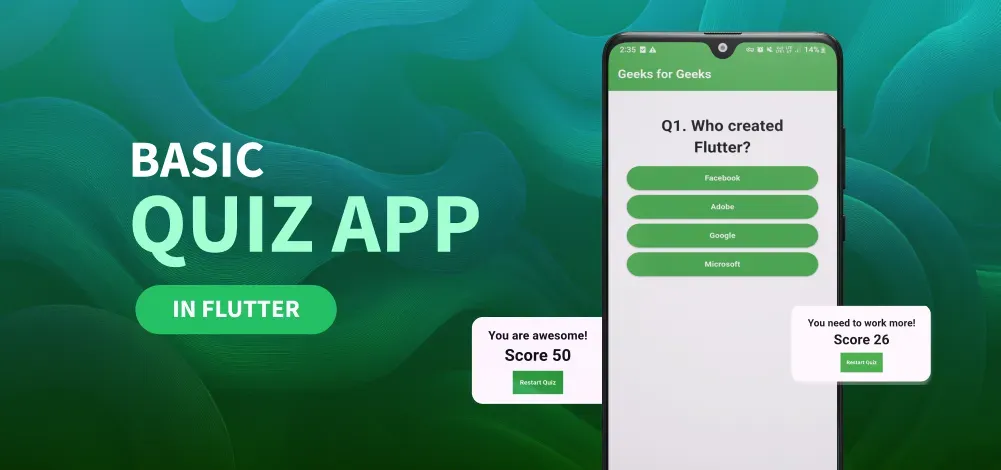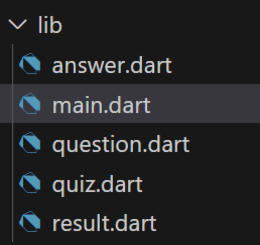Basic Quiz App In Flutter (original) (raw)
Last Updated : 10 May, 2025
**Flutter SDK is an open-source software development kit for building beautiful UI that is natively compiled. Currently, it is available as a stable version for iOS and Android OS.

In this app, we are going to have the features or modules mentioned below:
- Five multiple-choice questions ( more questions can be added ).
- Four selectable options for each question are in the form of buttons, except the last one.
- The score will be calculated based on the option selected for each question (Internally).
- Based on the final score, a remark will be shown at the end of the quiz in addition to the score and the restart button.
- There are two screens in the app: the home (where questions will be shown) and the result screen ( where the score and remarks will be shown).
- The whole app will be separated into five different modules, namely main.dart, question.dart, answer.dart, quiz.dart and result.dart.
Making this app will give you a good revision of Flutter and Dart basics. We are covering a lot of concepts, such as:
- Showing Widgets on the screen.
- Recycling Widgets.
- Changing Screens.
- Internal Logic
- and else.
To start making the app, we first have to create a Flutter project, which will give us many files and folders. In the Lib folder, a main.dart file is already present. Now, in the same folder, four files should be created:-
- question.dart
- answer.dart
- quiz.dart and
- result.dart
Step to build a Basic Quiz App in Flutter
Step 1: Create a new Flutter Application
Create a new Flutter application using the command Prompt. To create a new app, write the below command and run it.
flutter create app_name
To know more about it refer this article: Creating a Simple Application in Flutter.
Step 2: File Structure
Follow below file structure for better code organization.

**Step 3: In step one we are going to
- **Create MyApp class and make it Stateful.
- **Add questions for the home screen.
- **Create a widget tree for the home screen.
Starting with the main.dart file
**main.dart:
Dart `
import 'package:flutter/material.dart'; import './result.dart'; import './quiz.dart';
void main() => runApp(const MyApp());
class MyApp extends StatefulWidget { const MyApp({Key? key}) : super(key: key);
@override State createState() { return _MyAppState(); } }
class _MyAppState extends State { final _questions = const [ { 'questionText': 'Q1. Who created Flutter?', 'answers': [ {'text': 'Facebook', 'score': -2}, {'text': 'Adobe', 'score': -2}, {'text': 'Google', 'score': 10}, {'text': 'Microsoft', 'score': -2}, ], }, { 'questionText': 'Q2. What is Flutter?', 'answers': [ {'text': 'Android Development Kit', 'score': -2}, {'text': 'IOS Development Kit', 'score': -2}, {'text': 'Web Development Kit', 'score': -2}, { 'text':'SDK to build beautiful IOS, Android, Web & Desktop Native Apps', 'score': 10 }, ], }, { 'questionText': ' Q3. Which programming language is used by Flutter', 'answers': [ {'text': 'Ruby', 'score': -2}, {'text': 'Dart', 'score': 10}, {'text': 'C++', 'score': -2}, {'text': 'Kotlin', 'score': -2}, ], }, { 'questionText': 'Q4. Who created Dart programming language?', 'answers': [ {'text': 'Lars Bak and Kasper Lund', 'score': 10}, {'text': 'Brendan Eich', 'score': -2}, {'text': 'Bjarne Stroustrup', 'score': -2}, {'text': 'Jeremy Ashkenas', 'score': -2}, ], }, { 'questionText': 'Q5. Is Flutter for Web and Desktop available in stable version?', 'answers': [ {'text': 'Yes','score': -2,}, {'text': 'No', 'score': 10}, ], }, ];
var _questionIndex = 0; var _totalScore = 0;
void _resetQuiz() { setState(() { _questionIndex = 0; _totalScore = 0; }); }
void _answerQuestion(int score) {
if (_questionIndex < _questions.length)
{
setState(() {
_totalScore += score;
_questionIndex = _questionIndex + 1;
});
// ignore: avoid_print
print(_questionIndex);
if (_questionIndex < _questions.length) {
// ignore: avoid_print
print('We have more questions!');
} else {
// ignore: avoid_print
print('No more questions!');
}
}}
@override Widget build(BuildContext context) { return MaterialApp( home: Scaffold( appBar: AppBar( title: const Text('Geeks for Geeks'), backgroundColor: Colors.green, foregroundColor: Colors.white, ), body: Padding( padding: const EdgeInsets.all(30.0), child: _questionIndex < _questions.length ? Quiz( answerQuestion: _answerQuestion, questionIndex: _questionIndex, questions: _questions, ) //Quiz : Result(_totalScore, _resetQuiz), ), //Padding ), //Scaffold debugShowCheckedModeBanner: false, ); //MaterialApp } }
`
In Flutter**main.dart file is the entry point from which the code starts executing. In the main.dart file firstly material design package has been imported in addition to quiz.dart and result.dart _. Then a functionrunApp has been created with MyApp as the parameter. After the declaration of class MyApp which is a stateful widget, the state of class MyApp has been defined. Now that is followed by the four questions along with their respective answer options & score. And at the end, we have the widget tree for the home screen, which shows the _appBar with title, body with the questions and options. At the last, the debug banner has been disabled. We have classes like Quiz or Result, that will be defined in the following pages.
**Step 4: In step two we will create
- **Class Quiz (used in the home screen)
- **Widget tree for class Quiz
**quiz.dart
Dart `
import 'package:flutter/material.dart';
import './answer.dart'; import './question.dart';
class Quiz extends StatelessWidget { final List<Map<String, Object>> questions; final int questionIndex; final Function answerQuestion;
const Quiz({ Key? key, required this.questions, required this.answerQuestion, required this.questionIndex, }) : super(key: key);
@override Widget build(BuildContext context) { return Column( children: [ Question( questions[questionIndex]['questionText'].toString(), ), //Question ...(questions[questionIndex]['answers'] as List<Map<String, Object>>) .map((answer) { return Answer( () => answerQuestion(answer['score']), answer['text'].toString()); }).toList() ], ); //Column } }
`
This is the quiz.dart which was already imported in the main.dart file. In this file the class Quiz is being defined which is used in the main.dart file. Class Quiz has been extended as stateless widget as it does not need to change at any time in the run cycle of the app, which is followed by constructor Quiz. Then we have the widget tree that defines the structure of the class Quiz which basically displays the questions and their options. Again we have the class Question which will be defined in the _question.dart file.
**Step 5: In step three we will create
- Class Question (again used in the home screen)
- Widget tree for the class Question
**question.dart:
Dart `
import 'package:flutter/material.dart';
class Question extends StatelessWidget { final String questionText;
const Question(this.questionText, {Key? key}) : super(key: key);
@override Widget build(BuildContext context) { return Container( width: double.infinity, margin: const EdgeInsets.all(10), child: Text( questionText, style: const TextStyle(fontSize: 28), textAlign: TextAlign.center, ), //Text ); //Container } }
`
This **question.dart file has already been imported into the quiz.dart file, which uses the class Question. The class Question would be a stateless one similar to the Quiz it does not need to change during the run cycle. Then we have the constructor Question which is followed by the widget tree that gives structure to the Question widget.
**Step 6: In step four we will create
- Class Answer (used in the home screen)
- Widget tree for class Answer
**answer.dart:
Dart `
import 'package:flutter/material.dart';
class Answer extends StatelessWidget { final Function selectHandler; final String answerText;
const Answer({ Key? key, required this.selectHandler, required this.answerText, }) : super(key: key);
@override Widget build(BuildContext context) { return SizedBox( width: double.infinity, child: ElevatedButton( // Pass the function reference without invoking it. onPressed: () => selectHandler(), style: ElevatedButton.styleFrom( backgroundColor: Colors.green, foregroundColor: Colors.white), child: Text(answerText), ), ); } }
`
To know more about ElevatedButton in flutter refer this article: Flutter – ElevatedButton Widget.
This _answer.dart file was also imported in the**quiz.dart file. This file contains the Answer class which was used in the _quiz.dart file. Again similar to Quiz and Question class Answer would also be stateless. In the class Answer function, **selectHandler and a string answerText have been passed using the keyword final as they belong to the stateful widget and hence need to be declared as immutable, and not doing so will result in a dart analysis warning. That is followed by the constructor and the usual widget tree to give it a structure.
**Step 7: In the last step we will create
- **Class Result for (result screen)
- **Remark logic
- **Class Result widget tree
**result.dart:
Dart `
import 'package:flutter/material.dart';
class Result extends StatelessWidget { final int resultScore; final Function resetHandler;
const Result(this.resultScore, this.resetHandler, {Key? key}) : super(key: key);
String get resultPhrase { String resultText; if (resultScore >= 41) { resultText = 'You are awesome!'; print(resultScore); } else if (resultScore >= 31) { resultText = 'Pretty likeable!'; print(resultScore); } else if (resultScore >= 21) { resultText = 'You need to work more!'; } else if (resultScore >= 1) { resultText = 'You need to work hard!'; } else { resultText = 'This is a poor score!'; print(resultScore); } return resultText; }
@override Widget build(BuildContext context) { return Center( child: Column( mainAxisAlignment: MainAxisAlignment.center, children: [ Text( resultPhrase, style: const TextStyle(fontSize: 26, fontWeight: FontWeight.bold), textAlign: TextAlign.center, ), Text( 'Score $resultScore', style: const TextStyle(fontSize: 36, fontWeight: FontWeight.bold), textAlign: TextAlign.center, ), TextButton(
// Use a closure to pass the callback reference
// without invoking it immediately.
onPressed: () => resetHandler(),
child: Container(
color: Colors.green,
padding: const EdgeInsets.all(14),
child: const Text(
'Restart Quiz',
style: TextStyle(color: Colors.white),
),
),
),
],
),
);} }
`
This result.dart file had been imported in the main.dart file already as the class Result is defined in this file. Class Results will not change in the app run cycle therefore it is a stateless widget. As subclasses or variables which are used in the stateful widget need to be made immutable keyword final has been used, it is followed by the Result class. After that, we have the resulting logic which decides which remark would be shown after the quiz based on the final score. And at last, we have the widget tree that defines the structure of the class Result.
And now after completing the result.dart file our basic quiz app is completed now. We can preview the app in any physical device or emulator or even in the browser. It should look something like this.
**Output:
After the app has been finalized, apk for the app can be generated by giving the command 'flutter build apk' in the terminal.